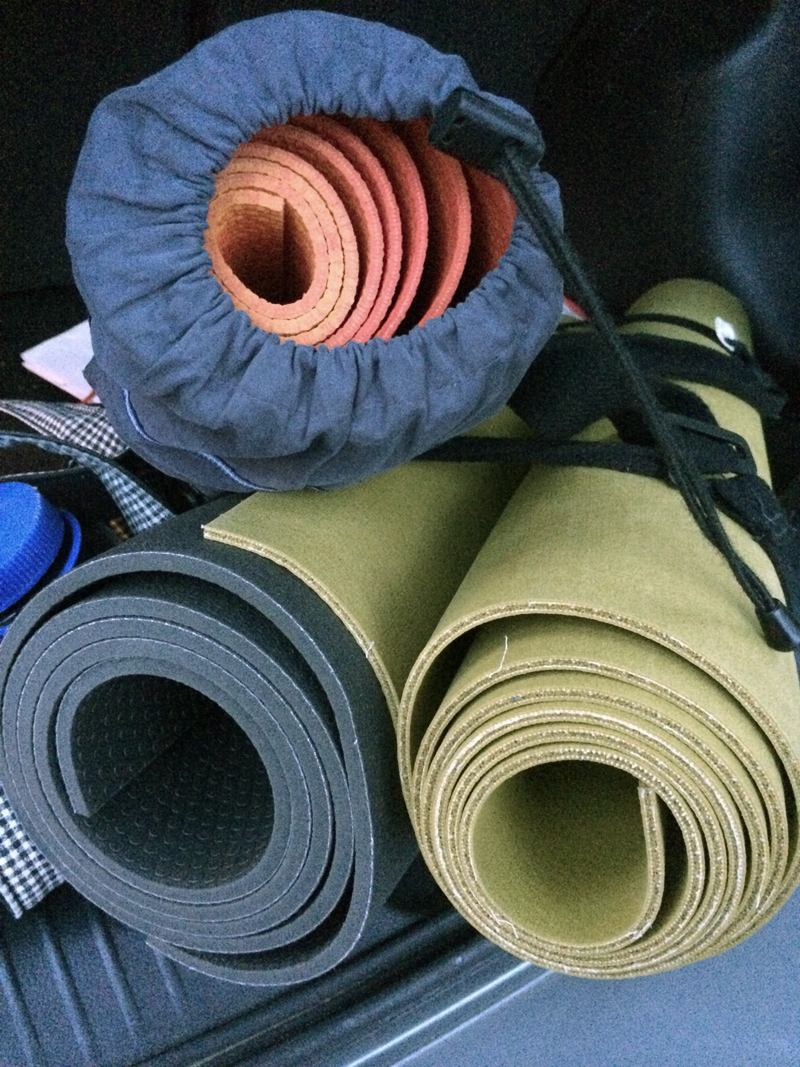
I just realized that it’s been 10 months since I set out to review some yoga mats. This is overdue! Here we go. Based on reviews I’d read online, I selected and purchased a Manduka PRO black mat, a Prana Revolution Mat (the olive-colored one, above), and a Manduka Eko Superlite Travel mat. I compared them with the mat I’ve been using for many years, a sunset-hued Hugger Mugger Tapas mat (pictured above, sheathed in a grey mat bag).
Thick and grippy…
Right now, my favorite mat for a vinyasa class or home practice, of the ones I’ve tried, is the Manduka PRO.

- It’s thick, so provides padding for knees, back of head, or whatever other body parts may need a little give during a practice in which you don’t move the mat around very much.
- Its substantial weight helps it not slide around much.
- It does tend to hold some of its curl (from storage/toting to class), but it doesn’t take long for it to release & flatten out.
- This brand guarantees their mats for life…
- …which is nice because they are expensive: $100, though you may be able to get a coupon directly from Manduka or discounts from other vendors.
- The progressively-recycled PVC material initially smelled a little differently than my old standard mat, though not so much now that I’ve, er, marked it with my own sweat (and later wiped it down with mat cleaner). A scented candle when I practice sometimes distracts my nose sufficiently. So does focusing my thoughts on my breath (of course): there’s practice available everywhere.
- I feel ambivalent about the black color, but I adore that little frog logo (the Manduka logo) that is visible during my practice. Irony: I dislike frog pose (Mandukasana).

Running a close second for me is the Prana Revolution Mat.
- It’s a little heavier than the Manduka PRO.
- It’s slightly less thick/padded.
- It flattens out very quickly (in fact, it can be difficult to roll it up and keep it rolled without a mat carrier strap).
- It’s wider than the standard yoga mat. I can see this being helpful for one pose in particular: wide-legged downward facing dog. And maybe quite a few running stretches. This extra width might pose a challenge if you attend jam-packed flow classes where the arrangement of 30+ yogis and their mats is already a mathematical –and social– puzzle.
- It also smells different. It’s made of natural rubber and is biodegradable, which is comforting, if you ever wear it out or tire of it.
- It now comes in more colors than when I ordered mine – the greenish clay color is attractive in … some light (it’s surprisingly similar in hue to the walls in our living room).
- My husband has claimed this one for his own use, and I think it’s because when it arrived it was very heavy and tubular and covered in thick shipping paper with caps on both ends. Gamer geek (and former boy) that he is, it bore a strong resemblance to a rocket launcher, especially after we removed one of the caps.
- This one costs $90, possibly cheaper if you can score a discount. REI sells these (and the Manduka PRO, as well), so this may be a good candidate for using your co-op dividend.
Those are the two I’d recommend if you would like a little more padding than the standard 10-30 dollar mat provides, and have the dough to invest in these practice partners-for-life. They are both pretty heavy, which might be problematic if you think you will need to carry it across town on your back (rather than just from your car’s trunk to the studio across the street).
One thing to keep in mind with the heavier mats is shipping costs, if you mail/internet order them. These could add up, if you don’t have a way (be it Amazon Prime or some other shipping discount option) to get free shipping. If for some reason you find yourself in the position of ordering at least $125 worth of stuff on the Manduka site, shipping is free, as advertised on the site, at least today.
… or lightweight and portable
If you go to an Iyengar class very often (like I do), a less heavy mat is helpful. In these classes, we tend move around the room a lot: once or twice to the wall, a few times turning our mats from vertical to horizontal orientation to the front of the room, later folding it into a blanket taco while preparing for salamba sarvangansana (supported shoulder stand), or rolling it up as padding and insulation from the seat of a folding chair. These small trips around the room or origami projects are a lot easier to manage with a lighter, more flexible mat. Extra padding can usually be found with folded-up blankets that are often available at Iyengar studios.

So, the mat I bring to such classes is a Hugger Mugger Tapas mat.
- I’ve never had it slide around on me.
- I’ve had it for many years and it isn’t showing much sign of age.
- I keep it in my car’s trunk, which is handy on some days, even though I prefer practicing on the Manduka PRO.
- I love, love LOVE its color: a sort of sunset-like blend of reds, oranges and golds.
- I also have an older, basic but extra-long blue PVC Hugger Mugger one that has started to drop bits of blue here and there. It’s destined for one of the yoga mat re-use projects detailed here.
And then there is super-portable
As a nearly last-minute decision to bring a mat with me (on a trip that we planned to only take carry-on luggage), I bought a really light, foldable version of the Manduka mat, the Eko Superlite on my travels in Asia, and I really liked it. Here’s a video I shot on the trip, that features a cameo of the mat right at the start:
- I traveled with a carry-on sized packpack, and the mat fit down the outside of the pack, cinched tight with the side straps. A few times, I folded it up and put it into the pack. It’s lightweight and extremely packable!
- It doesn’t offer much in the way of padding.
- It was sticky enough to keep my feet from sliding.
- It provided a nice barrier from sometimes questionably clean hotel room floors, which were most often tile or wood, on that trip. It sometimes moved around or bunched up on hard floors (just a little), but that wasn’t much of a problem for the small amount of mostly slow yoga I did while traveling. I suspect that when I use it for domestic travel, I’ll see more carpeting in rooms, which will provide a little traction and padding underneath the mat.
- The bright, cheerful color options were a plus; I chose a red that was called, strangely, “swoon.” Color is a powerful mood lifter for a lot of people. Everyone has a favorite color.
-

13 temples visited in 2 days? Hello, yoga mat on day 3. Additionally (and oddly), this mat’s earthy and strong natural rubber odor also helped transport me from whatever travel stresses drove me to the mat.
In conclusion: shop for your needs.
So, this concludes my view of some top-rated and/or familiar yoga mats. As I mentioned above, I prefer the Manduka PRO for my Vinyasa/flow yoga class and home practice, but keep a lightweight, standard $30 PVC mat in the car to take to Iyengar classes and the random yoga workshop.
This doesn’t mean the above mats would be the best solution for you, especially if you’re very new to yoga and not even sure that you’ll be spending all that much time on your mat, in the future. I’ve outlined several other personal factors to consider in my prior post about mats.
If you’ve got your heart set on one of the more expensive types, perhaps you can find one on Craig’s List? I saw one there in the Twin Cities CL site today for a very nice price. Good luck!